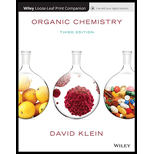
(a)
Interpretation:
For the rearrangement reaction of the given compound, the mechanism should be drawn, the type of Sigmatropic rearrangement should be identified and the reason for completion of reaction should be explained.
Concept introduction:
- Sigmatropic rearrangement reaction is a pericyclic reaction of polyenes (π-system), in which one σ-bond is formed and another σ-bond is broken and remaining π-bonds are shifting their positions. Thereby the transition state is cyclic. The mechanism of rearrangement is represented by using curved arrows.
- The Sigmatropic rearrangement reaction is represented by using two numbers in the brackets. The numbers represent the numbers of atoms separating the σ-bond which is breaking and the σ-bond which is forming.
- Three membered rings are highly unstable as compared to seven membered rings because the angle strain is increase with decrease in the bond angle.
(b)
Interpretation:
For the rearrangement reaction of the given compound, the mechanism should be drawn, the type of Sigmatropic rearrangement should be identified and the reason for completion of reaction should be explained.
Concept introduction:
- Sigmatropic rearrangement reaction is a pericyclic reaction of polyenes (π-system), in which one σ-bond is formed and another σ-bond is broken and remaining π-bonds are shifting their positions. Thereby the transition state is cyclic. The mechanism of rearrangement is represented by using curved arrows.
- The Sigmatropic rearrangement reaction is represented by using two numbers in the brackets. The numbers represent the numbers of atoms separating the σ-bond which is breaking and the σ-bond which is forming.
- Three membered rings are highly unstable as compared to seven membered rings because the angle strain is increase with decrease in the bond angle.
(c)
Interpretation:
For the rearrangement reaction of the given compound, the mechanism should be drawn, the type of Sigmatropic rearrangement should be identified and the reason for completion of reaction should be explained.
Concept introduction:
- Sigmatropic rearrangement reaction is a pericyclic reaction of polyenes (π-system), in which one σ-bond is formed and another σ-bond is broken and remaining π-bonds are shifting their positions. Thereby the transition state is cyclic. The mechanism of rearrangement is represented by using curved arrows.
- The Sigmatropic rearrangement reaction is represented by using two numbers in the brackets. The numbers represent the numbers of atoms separating the σ-bond which is breaking and the σ-bond which is forming.
- Three membered rings are highly unstable as compared to seven membered rings because the angle strain is increase with decrease in the bond angle.
Want to see the full answer?
Check out a sample textbook solution
Chapter 16 Solutions
ORGANIC CHEMISTRY-PRINT COMPANION (LL)
- Calculate the pH and the pOH of each of the following solutions at 25 °C for which the substances ionize completely: (a) 0.000259 M HClO4arrow_forwardWhat is the pH of a 1.0 L buffer made with 0.300 mol of HF (Ka = 6.8 × 10⁻⁴) and 0.200 mol of NaF to which 0.160 mol of NaOH were added?arrow_forwardDetermine if the following salt is neutral, acidic or basic. If acidic or basic, write the appropriate equilibrium equation for the acid or base that exists when the salt is dissolved in aqueous solution. If neutral, simply write only NR. Be sure to include the proper phases for all species within the reaction. NaN₃arrow_forward
- A. Draw the structure of each of the following alcohols. Then draw and name the product you would expect to produce by the oxidation of each. a. 4-Methyl-2-heptanol b. 3,4-Dimethyl-1-pentanol c. 4-Ethyl-2-heptanol d. 5,7-Dichloro-3-heptanolarrow_forwardWhat is the pH of a 1.0 L buffer made with 0.300 mol of HF (Ka = 6.8 × 10⁻⁴) and 0.200 mol of NaF to which 0.160 mol of NaOH were added?arrow_forwardCan I please get help with this.arrow_forward
- Determine if the following salt is neutral, acidic or basic. If acidic or basic, write the appropriate equilibrium equation for the acid or base that exists when the salt is dissolved in aqueous solution. If neutral, simply write only NR. Be sure to include the proper phases for all species within the reaction. N₂H₅ClO₄arrow_forwardPlease help me with identifying these.arrow_forwardCan I please get help with this?arrow_forward
 ChemistryChemistryISBN:9781305957404Author:Steven S. Zumdahl, Susan A. Zumdahl, Donald J. DeCostePublisher:Cengage Learning
ChemistryChemistryISBN:9781305957404Author:Steven S. Zumdahl, Susan A. Zumdahl, Donald J. DeCostePublisher:Cengage Learning ChemistryChemistryISBN:9781259911156Author:Raymond Chang Dr., Jason Overby ProfessorPublisher:McGraw-Hill Education
ChemistryChemistryISBN:9781259911156Author:Raymond Chang Dr., Jason Overby ProfessorPublisher:McGraw-Hill Education Principles of Instrumental AnalysisChemistryISBN:9781305577213Author:Douglas A. Skoog, F. James Holler, Stanley R. CrouchPublisher:Cengage Learning
Principles of Instrumental AnalysisChemistryISBN:9781305577213Author:Douglas A. Skoog, F. James Holler, Stanley R. CrouchPublisher:Cengage Learning Organic ChemistryChemistryISBN:9780078021558Author:Janice Gorzynski Smith Dr.Publisher:McGraw-Hill Education
Organic ChemistryChemistryISBN:9780078021558Author:Janice Gorzynski Smith Dr.Publisher:McGraw-Hill Education Chemistry: Principles and ReactionsChemistryISBN:9781305079373Author:William L. Masterton, Cecile N. HurleyPublisher:Cengage Learning
Chemistry: Principles and ReactionsChemistryISBN:9781305079373Author:William L. Masterton, Cecile N. HurleyPublisher:Cengage Learning Elementary Principles of Chemical Processes, Bind...ChemistryISBN:9781118431221Author:Richard M. Felder, Ronald W. Rousseau, Lisa G. BullardPublisher:WILEY
Elementary Principles of Chemical Processes, Bind...ChemistryISBN:9781118431221Author:Richard M. Felder, Ronald W. Rousseau, Lisa G. BullardPublisher:WILEY





